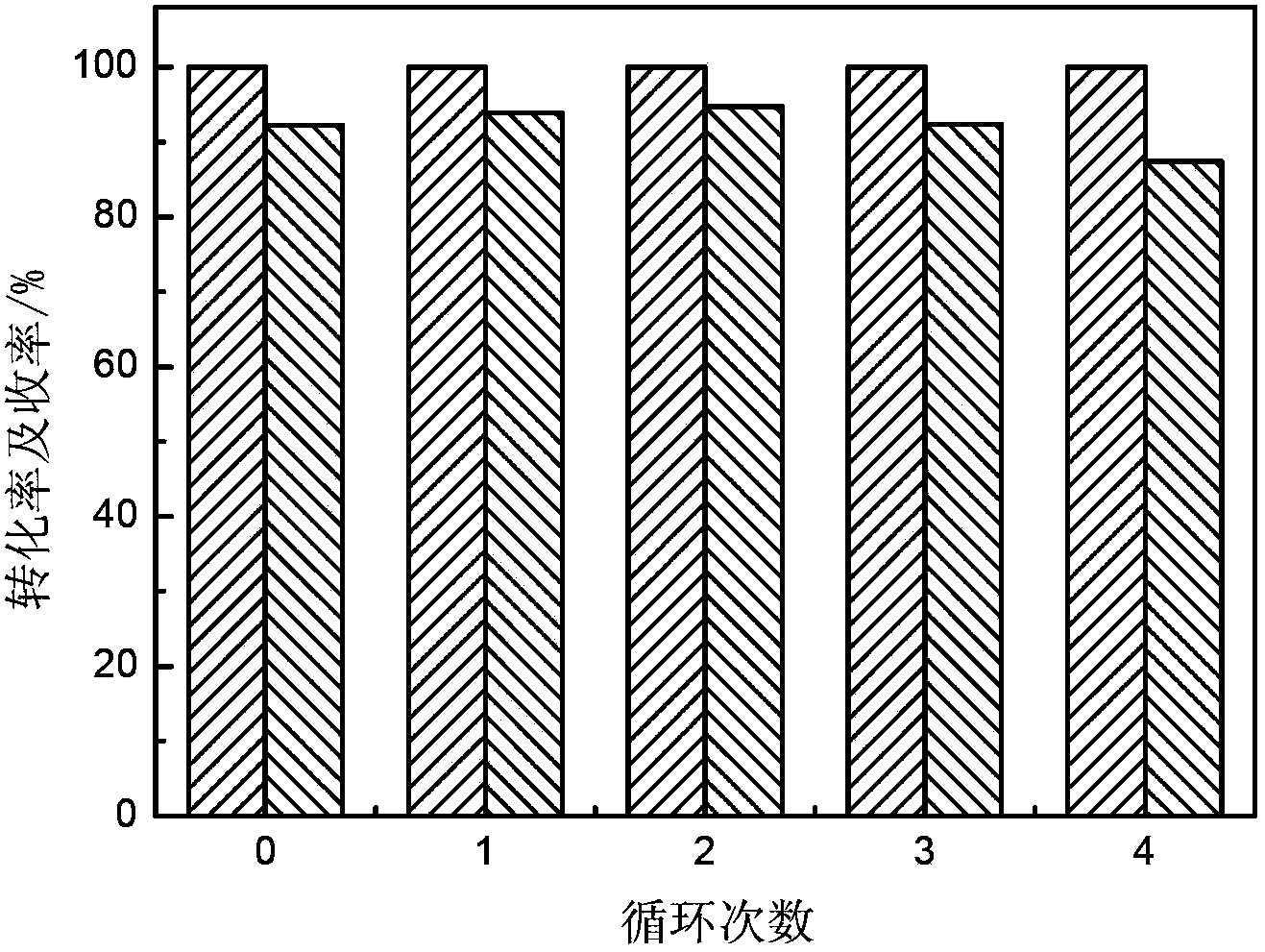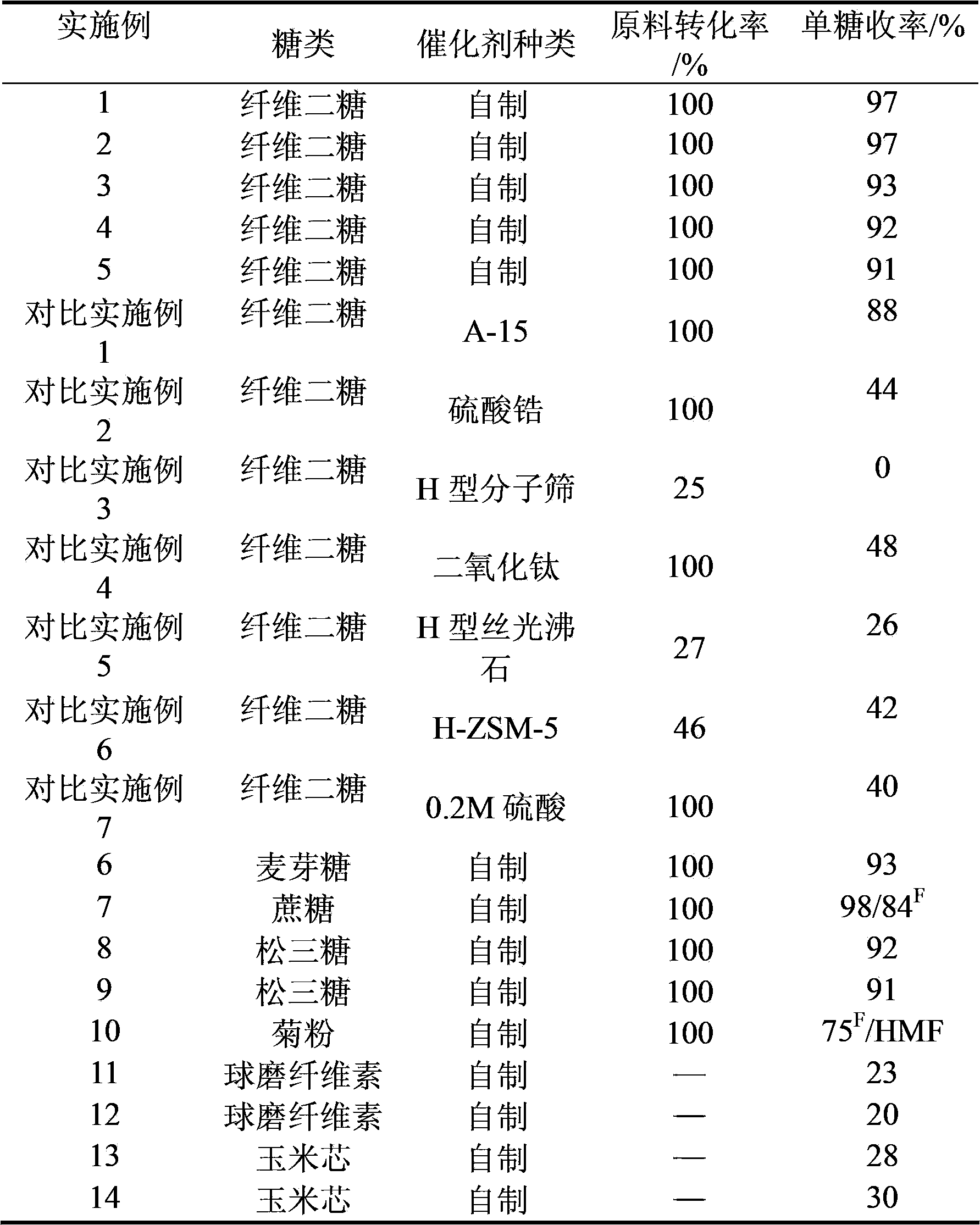Method and catalyst for hydrolyzing saccharide compounds
An aldehyde compound, compound technology, applied in organic compound/hydride/coordination complex catalysts, physical/chemical process catalysts, chemical instruments and methods, etc., can solve the problem of high energy consumption and long preparation steps for preparing carbon supports problem, to achieve the effect of strong acidity, low cost and long catalyst life
- Summary
- Abstract
- Description
- Claims
- Application Information
AI Technical Summary
Problems solved by technology
Method used
Image
Examples
Embodiment 1
[0020] Weigh 50g of sodium lignosulfonate and prepare an aqueous solution with a mass concentration of 15%. Add 25g of furfural to a pressure-resistant polyester bottle, add 5g of SBA-15 as a template, mix, stir, and drop the mass fraction into the reaction vessel. 15g of 37% hydrochloric acid, stir until the solution is evenly mixed, airtight, and place in an oven at 100°C to react for 24 hours. Then the prepared black material was dried at 110°C, ground, treated with hydrofluoric acid at room temperature for more than 12 hours to remove the template, treated with 1M sulfuric acid for 2 hours to ensure that the sodium ions were completely exchanged, washed until there was no sulfate ions, dried, The biomass acid material is obtained. This material is used as a catalyst for the hydrolysis of sugars. Add 5g of this catalyst and 30g of cellobiose into the reaction kettle, add 75mL of water, stir and react for 4h at 120°C, centrifuge for separation, and detect the conversion of r...
Embodiment 2
[0022] Weigh 50g of sodium lignosulfonate and prepare it into an aqueous solution with a mass concentration of 15%. Add 25g of a 37% formaldehyde solution to a pressure-resistant polyester bottle. Add 5g of SBA-15 as a template, mix, stir, and react. Add 15 g of hydrochloric acid with a mass fraction of 37% to the container, stir until the solution is evenly mixed, airtight, and place in an oven at 100°C to react for 24 hours. Then the prepared black material was dried at 110°C, ground, treated with hydrofluoric acid at room temperature for more than 12 hours to remove the template, treated with 1M sulfuric acid for 2 hours to ensure that the sodium ions were completely exchanged, washed until there was no sulfate ions, dried, The biomass acid material is obtained. This material is used as a catalyst for the hydrolysis of sugars. Add 5g of this catalyst and 30g of cellobiose into the reaction kettle, add 75mL of water, stir and react for 4h at 120°C, centrifuge for separation,...
Embodiment 3
[0024] Add 50g of magnesium lignosulfonate into an aqueous solution with a mass concentration of 25%, and add 25g of a 37% formaldehyde solution to a pressure-resistant polyester bottle, add 5g of SBA-15 as a template, mix, stir, and add to the reaction vessel Add 15 g of 37% hydrochloric acid in the medium dropwise, stir until the solution is evenly mixed, airtight, and place in an oven at 100°C to react for 24 hours. Then the prepared black material was dried at 110°C, ground, treated with hydrofluoric acid at room temperature for more than 12 hours to remove the template, treated with 1M sulfuric acid for 2 hours to ensure that the sodium ions were completely exchanged, washed until there was no sulfate ions, dried, The biomass acid material is obtained. This material is used as a catalyst for the hydrolysis of sugars. Add 5g of this catalyst and 30g of cellobiose into the reaction kettle, add 75mL of water, stir and react for 4h at 120°C, centrifuge for separation, and det...
PUM
 Login to View More
Login to View More Abstract
Description
Claims
Application Information
 Login to View More
Login to View More - R&D
- Intellectual Property
- Life Sciences
- Materials
- Tech Scout
- Unparalleled Data Quality
- Higher Quality Content
- 60% Fewer Hallucinations
Browse by: Latest US Patents, China's latest patents, Technical Efficacy Thesaurus, Application Domain, Technology Topic, Popular Technical Reports.
© 2025 PatSnap. All rights reserved.Legal|Privacy policy|Modern Slavery Act Transparency Statement|Sitemap|About US| Contact US: help@patsnap.com


